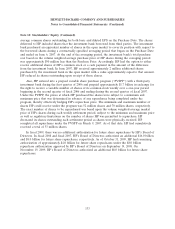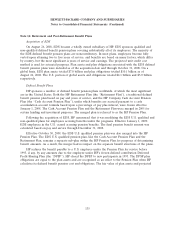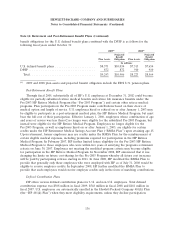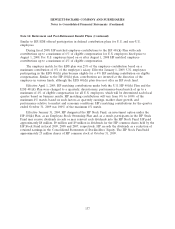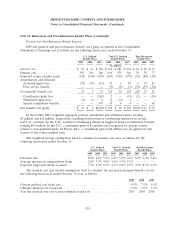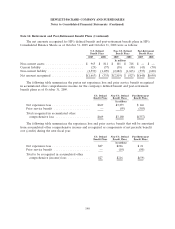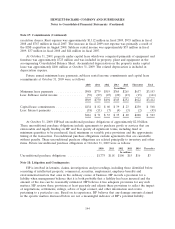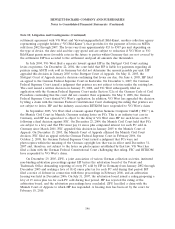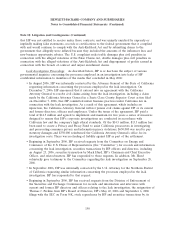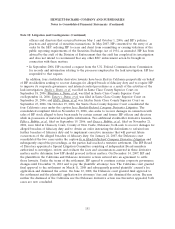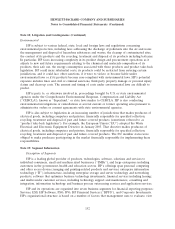HP 2009 Annual Report Download - page 149
Download and view the complete annual report
Please find page 149 of the 2009 HP annual report below. You can navigate through the pages in the report by either clicking on the pages listed below, or by using the keyword search tool below to find specific information within the annual report.
HEWLETT-PACKARD COMPANY AND SUBSIDIARIES
Notes to Consolidated Financial Statements (Continued)
Note 16: Retirement and Post-Retirement Benefit Plans (Continued)
Plan Asset Allocations
The weighted-average target and actual asset allocations across the HP and EDS plans at the
respective measurement dates were as follows:
U. S. Defined Non-U.S. Defined Post-Retirement
Benefit Plans Benefit Plans Benefit Plans
2009 2009 2009
Plan Assets Plan Assets Plan Assets
Target Target Target
Asset Category Allocation 2009 2008 Allocation 2009 2008 Allocation 2009 2008
Public equity securities ...... 29.3% 27.1% 61.6% 59.5% 36.5% 49.5%
Private equity securities ..... 10.9% 14.6% — — 33.5% 22.9%
Real estate and other ....... 0.3% 0.5% 4.2% 6.2% 1.3% 2.1%
Equity-related investments . . . 40.0% 40.5% 42.2% 65.5% 65.8% 65.7% 71.5% 71.3% 74.5%
Public debt securities ....... 60.0% 58.7% 56.7% 34.5% 32.9% 33.4% 27.5% 25.9% 23.6%
Cash .................. 0.0% 0.8% 1.1% 0.0% 1.3% 0.9% 1.0% 2.8% 1.9%
Total ................. 100.0% 100.0% 100.0% 100.0% 100.0% 100.0% 100.0% 100.0% 100.0%
Investment Policy
HP’s investment strategy for worldwide plan assets is to seek a competitive rate of return relative
to an appropriate level of risk depending on the funded status of each plan. The majority of the plans’
investment managers employ active investment management strategies with the goal of outperforming
the broad markets in which they invest. Risk management practices include diversification across asset
classes and investment styles and periodic rebalancing toward asset allocation targets. A number of the
plans’ investment managers are authorized to utilize derivatives for investment or liability exposures,
and HP utilizes derivatives to effect asset allocation changes or to hedge certain investment or liability
exposures.
The target asset allocation selected for each U.S. plan reflects a risk/return profile HP feels is
appropriate relative to each plan’s liability structure and return goals. HP conducts periodic asset-
liability studies for U.S. plan assets in order to model various potential asset allocations in comparison
to each plan’s forecasted liabilities and liquidity needs. HP invests a portion of the U.S. defined benefit
plan assets and post-retirement benefit plan assets in private market securities such as venture capital
funds, private debt and private equity to provide diversification and higher expected returns.
Outside the United States, asset allocation decisions are typically made by an independent board
of trustees. As in the U.S., investment objectives are aligned to generate returns that will enable the
plan to meet its future obligations. In some countries local regulations require adjustments in asset
allocation, typically leading to a higher percentage in fixed income than would otherwise be deployed.
HP’s corporate office acts in a consulting and governance role in reviewing investment strategy and
providing a recommended list of investment managers for each country plan, with final decisions on
asset allocation and investment managers made by local trustees.
Basis for Expected Long-Term Rate of Return on Plan Assets
The expected long-term rate of return on assets for each U.S. plan reflects the expected returns
for each major asset class in which the plan invests and the weight of each asset class in the target mix.
142



